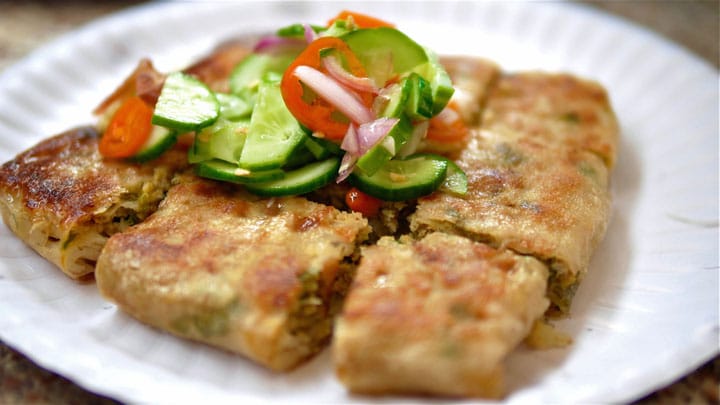
Sharpen your taste buds, because we are going on a culinary journey to the heart of Southeast Asia: Thailand. Here you will find the underrated but very flavorful dish, Roti Mataba Nuea (โรตีมะตะบะเนื้อ). Also known in English as Thai Beef Stuffed Roti.
In Thai, โรตีมะตะบะเนื้อ is pronounced “Roti Mataba Nuea”. If we translate this into the International Phonetic Alphabet (IPA), the phonetic transcription would be something like /rōː-tiː ma-tá-bà nʉ́ʉa/.
Origin and history
Although we consider this dish to be quintessentially Thai, it is actually the result of a special melting pot of cultures. Roti Mataba Nuea originates from the southern regions of Thailand, where influences from Malaysian, Indian and Arabic cuisines come together. The roti, a type of flatbread found in many Asian cuisines, was brought to the area by Indian traders. Mataba, which means 'filled' in Arabic, indicates the Arab influence.
This dish has taken on different shapes and flavors over the centuries, but the essence remains the same: a tasty filling of beef (or variations with chicken or fish), wrapped in a crispy roti. Although it is sold on the street as a snack all over Thailand, we are also seeing it increasingly served in Thai restaurants around the world.
Ingredients and flavor profiles
The beauty of Roti Mataba Nuea is the harmony of complex flavors this dish has to offer. You can taste the spiciness of the beef, enhanced by spices such as cumin and coriander, the sweetness of the onions, and the subtle flavor of the roti, which has been made crispy by the filling.
The filling usually consists of beef, onions, garlic, ginger, cumin, coriander, turmeric, pepper and salt. Sometimes green peppers are also added for an extra kick. The roti itself is made from a simple dough of flour, water and salt, which is then rolled out thinly and folded around the filling.
Recipe for 4 people
Fancy trying this exotic dish for yourself? Here's a simple recipe for four people.
Ingredients:
- For the roti:
- 2 cups of flour
- 1/2 cup of water
- 1 / 2 teaspoon of salt
- For the filling:
- 500 grams of beef, cut into small pieces
- 2 large onions, finely chopped
- 4 cloves garlic, minced
- 1 piece of ginger (about 2 cm), finely chopped
- 1 teaspoon of cumin
- 1 teaspoon of cilantro
- 1/2 teaspoon of turmeric
- Pepper and salt to taste
- Oil for baking
Preparation method:
- Start by making the dough for the roti. Mix the flour and salt in a bowl. Slowly add the water while kneading. When the dough is smooth and elastic, cover and let rest for 30 minutes.
- While the dough is resting, prepare the filling. Heat the oil in a pan and add the onions, garlic and ginger. Fry until the onions are golden brown.
- Add the beef and cook until browned. Then add the spices and mix everything well. Let the mixture simmer for 5-10 minutes to allow the flavors to blend well.
- Divide the dough into four equal pieces. Roll each piece into a thin circle. Divide the filling evenly over the four rotis.
- Fold the edges of the rotis inwards to form a square package with the filling in the middle.
- Heat some oil in a pan and fry each roti on both sides until golden brown. Serve warm and enjoy the taste explosion of Roti Mataba Nuea!
Trying new dishes is like exploring new cultures. By making Roti Mataba Nuea, you get a taste of Thailand's rich and diverse culinary traditions.
Have fun cooking and enjoy your meal!


To be honest… I never see this on the various menus. What am I missing? Is there a restaurant in Pattaya or rather in Jomtien that serves this dish?
It looks good. 'Roti' suggests an Indian origin. Well, of course there is. But where can I taste this 'typical Thai dish'?
Maybe at local markets in Pattaya/Jomtien.
If you travel to Narathiwat province, you will not have to make any effort, because it is for sale everywhere there.